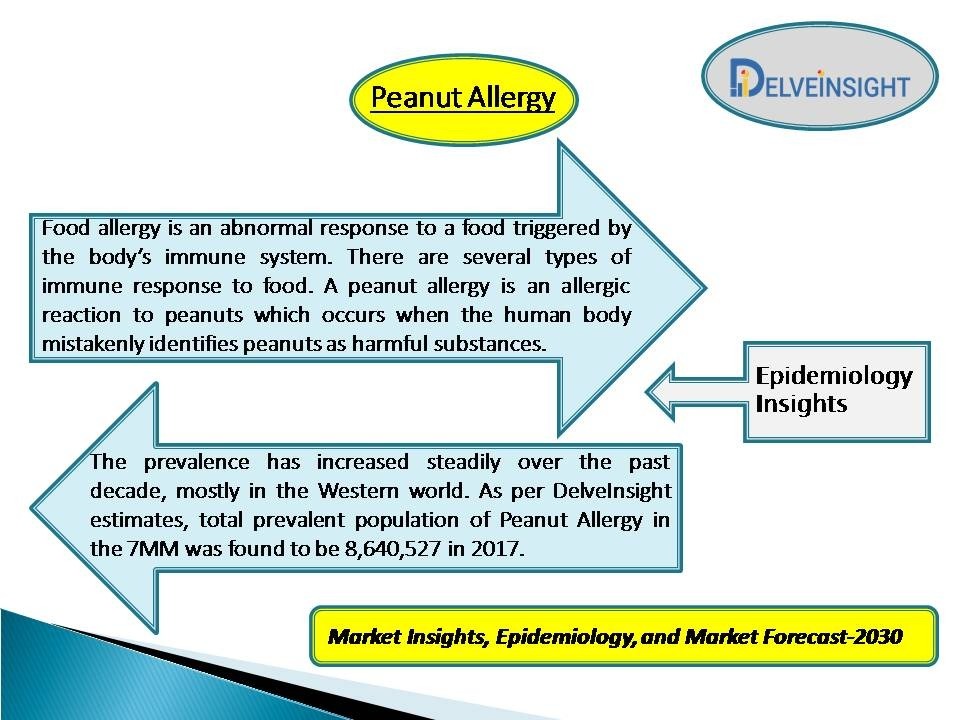
DelveInsight's Peanut Allergy Market Insights, Epidemiology and Market Forecast-2028' report delivers an in-depth understanding of the disease, historical & forecasted epidemiology as well as the market trends of Peanut Allergy in the United States, EU5 (Germany, Spain, Italy, France and United Kingdom), and Japan.
The Report provides the current treatment practices, emerging drugs, Peanut Allergy drug market share of the individual therapies, current and forecasted market size of Peanut Allergy from 2017 to 2028 segmented by seven major markets. The Report also covers current treatment practice/algorithm, market drivers, market barriers and unmet medical needs to curate best of the opportunities and assess underlying potential of the market
A peanut allergy is an allergic reaction to peanuts which occurs when the human body mistakenly identifies peanuts as harmful substances. Peanuts are not the same as tree nuts (almonds, cashews, walnuts, etc.), which grow on trees.
In botanical terms, the peanut is not a nut, but a legume. It is one of the types of food that often provoke severe allergic reactions. In some cases, trace amounts of one milligram can trigger a reaction. In comparison, a peanut weighs between 500 and 1000 milligrams.
Peanut allergy is recognized as one of the most severe food allergies due to its prevalence, persistency, and the potential severity of the allergic reaction. Although other food allergies occurring in childhood usually resolve spontaneously with age, peanut sensitivity appears early in life and often persists indefinitely.
Frequently, large quantities of peanut allergens are not needed to elicit an allergic reaction—even trace levels of peanut are capable of causing a hypersensitive reaction. Peanut allergy is estimated to affect 0.5-1.1% of the population, depending on the area studied.
Peanut-allergic individuals may experience symptoms ranging from mild urticaria, facial swelling, and abdominal cramp to hypertension with anaphylactic shock. In fact, it is the most common cause of fatal food-related anaphylaxis.
The DelveInsight Peanut Allergy market report gives a thorough understanding of the Peanut Allergy by including details such as disease definition, classification, symptoms, etiology, pathophysiology, diagnostic trends. It also provides treatment algorithms and treatment guidelines for Peanut Allergy in the US, Europe, and Japan
The Peanut Allergy epidemiology division provide the insights about historical and current patient pool and forecasted trend for every 7 major countries. It helps to recognize the causes of current and forecasted trends by exploring numerous studies and views of key opinion leaders. This part of the DelveInsight report also provides the diagnosed and treatable patient pool and their trends along with assumptions undertaken.
The disease epidemiology covered in the report is segmented by total prevalent population, age-specific prevalent population, gender-specific prevalent population and severity-specific prevalent population.
The DelveInsight report also provides the epidemiology trends observed in the 7MM during the study period, along with the assumptions undertaken. The calculated data are presented with relevant tables and graphs to give a clear view of the epidemiology at first sight.
According to DelveInsight, the prevalent population of Peanut Allergy was estimated to be 8,693,872 [7MM] in 2018. United States accounts for the highest Peanut Allergy cases, followed by EU5 (Germany, France, Italy, Spain & UK) and Japan. Among the EU5 countries France had the highest prevalent patient population of Peanut Allergy pipeline, followed by Germany.
Currently, there is no standard of care for patients with Peanut Allergy market research report, highlighting a pressing need to develop safe and effective curative interventions. The primary care of treatment, include antihistamines and injectible epinephrine, prescribed to patients with mild, and moderate to severe cases of Peanut Allergy. However all these therapies are used as off-label therapies and there is no approved therapy yet for the treatment of Peanut Allergy
The primary care of treatment, include antihistamines and injectible epinephrine, prescribed to patients with mild, and moderate to severe cases of Peanut Allergy.
Antihistamines, known as H1 blockers, are beneficial for the treatment of acute mild reactions, (e.g., itching, sneezing, hives and rashes), although they cannot stop or control a severe reaction. Medications in this class include diphendydramine and cetirizine.
Antihistamines do not treat anaphylaxis and have no life-saving capacity. Diphenhydramine has been commonly used as the antihistamine of choice for acute food allergic reactions given its prompt onset of action and ready availability, though epinephrine is still the first-line therapy for anaphylaxis. Cetirizine is a second generation antihistamine with a similar onset but longer duration of action (?24 hours) compared to diphenhydramine.
Furthermore, CNS effects are less commonly reported. Cetirizine has been used by patients in outpatient clinic for the treatment of acute allergic food reactions.
In order to meet the high unmet need of Peanut Allergy treatment regimen, companies across the globe have shifted their focus towards this therapeutic area.
Recent studies show promise in the effectiveness and safety of oral immunotherapy (OIT), sublingual immunotherapy (SLIT), and epicutaneous immunotherapy (EPIT). Additionally, improved diagnostic testing provides more accurate results while minimizing risk.
Comments
Post a Comment